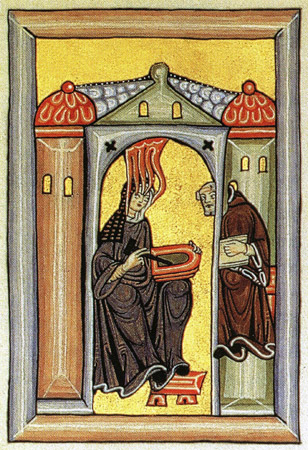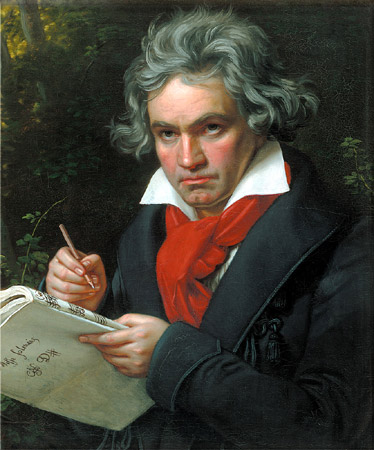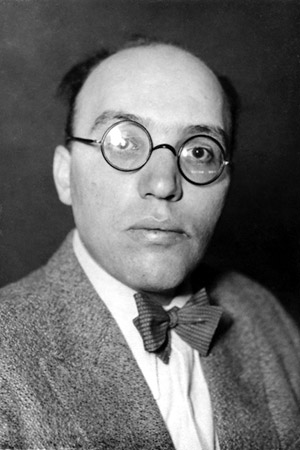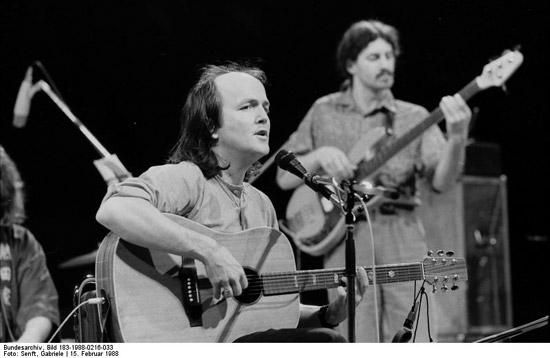Music: Traditional Forms
Medieval Music
Hildegard von Bingen
Hildegard von Bingen, the earliest known German composer, was a mystic who wrote liturgical plainchant antiphons, responsories, sequences, and hymns using fourths and fifths along with the smaller intervals typical of the time. Her music was lyrically effusive and contrasted neumatic with melismatic passages, rising quickly and falling slowly as opposed to more traditional gradual arcs. She also composed the first musical drama in history, The Ritual of the Virtues.
Minnesingers and Meistersingers
Minnesingers (love poets) wrote and sang courtly love songs, sometimes simply called lieder (songs), from the 12th to the 14th centuries. The majority of minnesingers were aristocrats like Walther von der Vogelweide, while the meistersingers (master singers) who followed were commoners in specialized guilds who composed lyric poetry and unaccompanied art songs between the 14th and 16th centuries. Both minnesingers and meistersingers took their roots from the French troubadours and trouvère as well as from Gregorian chant and popular song.
The meistersingers frequently used bar form (AAB) and other forms with three strophes to produce unaccompanied monophonic, pentatonic songs like “Fettdachsweis, Vielfrassweis” (“Melody of Eating Much”) according to highly technical rhythmic and rhyming requirements. Akin to the French lai, the meistersingers’ Leichen were several hundred short stanzas containing repeated religious motifs, usually in couplets with individual music assigned to each. The meistersingers gave music a new social status and civic value, which was later reflected in Germany’s municipal bands.
Classical
Bach, Beethoven, and Brahms—widely considered three of the world’s greatest composers—all hailed from Germany.
Johann Sebastian Bach
Baroque composer and organist Johann Sebastian Bach (1685–1750) was renowned for his innovative contrapuntal technique and for his motivic control. His music synthesized rhythms and techniques from other countries, notably Italy and France. Unusual at the time, Bach was extremely structured in both form—for example, the canons in the Goldberg Variations and the fugues in The Art of the Fugue—and detailed melodic notation for the performer. Some of Bach’s most famous works include the Well-Tempered Clavier, the St. John Passion, the Brandenburg Concertos, the cello suites, and numerous cantatas.
Ludwig van Beethoven
Ludwig van Beethoven (1770–1827) was a composer and pianist who bridged the Classical and Romantic periods. He composed music on a grand scale for larger orchestras, making the lower range of the string section the core of a darker, heavier sound. Employing his germ-motif invention as a unifying technique, Beethoven used modulation to extend themes and motifs between different keys throughout the movements of pieces such as the Pathetique Sonata and Symphony No. 8. Symphony No. 5 exemplifies cyclic form. His best-known output includes nine symphonies, 32 piano sonatas (including the Moonlight Sonata), 5 piano concertos, numerous string quartets, the operas Fidelio and Leonore, and a bagatelle called “Für Elise.”
Johannes Brahms
An ardent admirer of Bach and Beethoven, Johannes Brahms was a Romantic composer and pianist who used counterpoint, development, and other Baroque and Classical compositional techniques to produce highly structured pieces with lush emotional impact. Continuing the tradition of the art song introduced by the minnesingers and meistersingers, Brahms set piano and voice to almost 150 German folk Lieder. In fact, folk and dance songs such as the Hungarian Dances and the “Wiegenlied” (now known as "Brahms’ Lullaby") are among his most popular pieces. In addition, Brahms composed four symphonies, a number of concertos, and numerous variations, ballades, and rhapsodies for piano.
Richard Wagner
Most famous for his 13 operas, for which he wrote his own libretti, Richard Wagner was a composer whose work was viewed as a direct contrast to the so-called “purist” creations of Brahms. He invented the concept of Gesamtkunstwerk (total work of art), meant to combine music with drama, poetry, and visual art, most closely achieved in his four-opera cycle Der Ring des Nibelungen (The Ring of the Nibelungen). Wagner pushed the limits of tonality, employing chromaticism and changing tonal centers, notably with operas like Tristan und Isolde. He also invented the leitmotiv (or leitmotif), a musical theme connected with ideas, characters, places, and plot elements. The Tristan chord, part of one such eponymous leitmotif, is essentially a half-diminished seventh chord that many consider a precursor to atonality, due to its ambiguous relation to the implied surrounding key.
Kurt Weill
Born into a religious Jewish family (his father was a cantor) Kurt Weill, primarily known as a leading stage composer from the first half of the 20th century, is associated with cabaret, and believed the music he wrote should have a social purpose. The Threepenny Opera, a collaboration with Bertolt Brecht that contains “Mack the Knife” (a song Weill composed that is now considered a jazz standard), critiques capitalism from a Marxist standpoint. Weill fled Germany in 1933, ending up in New York, where he continued composing music for the stage—including Broadway—until his death in 1950 (at age 50).
Karlheinz Stockhausen
Karlheinz Stockhausen’s innovative theoretical writings and experiments in electronic music greatly influenced the genre’s development in the 1950s and 1960s. His considerable output includes aleatoric pieces like Klavierstück XI, serial compositions like Kreuzspiel and Formel, and pieces experimenting with spatialization such as the electronic Hymnen and Kontakte, as well as instrumental/vocal works such as Gruppen and Carré.
Folk
Songs of the People
The term Volkslieder (folksongs) has held many different meanings throughout Germany’s history. Along with highly localized dialect songs, some of the first classic German Volkslieder were strophic narrative ballads sung in High German, as well as literary Flugblattlieder (broadsides). In older folksongs, which Germans sang at fairs, in the marketplace, in guilds, and during other social functions, the melody usually moves in steps and thirds.
Volkslieder can be divided into both social and political categories, the latter including Heimatlieder (songs of the homeland) and the 20th-century Arbeiterlieder (workers’ songs). Later Volkslieder were arranged for German choruses, sparking the Wandervogel (wandering bird) movement, a symbolic return to nature. During the Nazi period, Hitler attempted to co-opt and monopolize the production of Volkslieder, along with others forms of music, resulting in jingoistic pieces and songs—and in a certain ambivalence about the term among contemporary Germans.
Pop-Folk Songs
Schlager, roughly translating to “a hit,” is a form of sentimental, catchy popular music with simple melodies and lyrics usually focusing on emotions. Most popular in the 1960s and 1970s, Schlager has recently experienced a kitsch revival. Well-known Schlager artists include Rex Gildo and Gitte Hænning.
Brass Bands
German brass bands play oom-pah music, named after the ostinato-like sound of a low-range brass instrument such as a tuba. The tuba creates the “oom” by alternating from the root to the fifth of the chord, while instruments with a higher range, such as the trombone, accordion, or clarinet, play the “pah” on offbeats. Oom-pah is often used in polka as well as in Volkstümliche Musik, a variant of traditional folk mixed with popular music that’s prevalent in Alpine region broadcast media.
Revivals and Festivals
Spurred by the Cold War, musicians penned emigration and work songs, as well as pro-democracy pieces like the politically coded songs of Gerhard Gundermann and Oktoberclub from East Germany, during a folk music revival in the 1960s and 1970s. East Germany held the Festival des politischen Liedes (Festival of Political Song), featuring politically oriented music from 30 other countries, until the 1990s.
Cabaret
German Kabarett (cabaret), an intimate form of comedic theatrical entertainment in restaurants and nightclubs, developed in the early 1900s with the construction of the Überbrettl (Superstage) venue. Kabarett features gallows humor and political satire, unlike the French version of cabaret from which it derived. Notable Kabarett composers include Mischa Spoliansky and Friedrich Hollaender.
Swing
An early-20th-century form of jazz performed by big bands of brass and wind instruments such as trumpets, trombones, clarinets, and saxophones backed by a drum-and-double-bass rhythm section, with compositions featuring a succession of soloists sandwiched between opening and closing statements of a melody (the “head”), swing enjoyed great popularity during Germany’s Weimar Republic period. The genre’s characteristic rhythm involves a lilting, unequal, or syncopated groove, encouraging listeners to dance.
Because it was often performed by African Americans and Jews, the Nazis viewed swing as a degenerate, depraved form of jazz music. In opposition to the strict repression of the Gestapo and the Hitler Youth, high school aged individuals known as Swingjugend (Swing Youth or Swing Kids) in Berlin and Hamburg embraced swing music, which they viewed as liberating, along with other cultural aspects of America. The Swing Kids met in dance halls, private residences, and places like Café Heinze. While not initially political, the Swing Kids ultimately served as nonviolent protestors against National Socialism.
Regional and Ethnic Forms
The Sorbs are a small official ethnic minority of about 60,000 Western Slavs living in Saxony and Brandenburg. Sorbians residing in the Lusatian region of Germany observe the annual festival of Zapust, which celebrates rural life during several days in spring, before villagers sow their crops. During Zapust, musicians play folk songs and serenades accompanying a carnival, parade, and dance. Traditional instruments include the three-string fiddle, bagpipes, and accordion. The Lusatian International Folklore Festival features groups such as Schmerlitz and Sprjewjan—folk dancing and singing ensembles respectively.
Article written for World Trade Press by Jen Shipon.
Copyright © 1993—2025 World Trade Press. All rights reserved.

 Germany
Germany 



